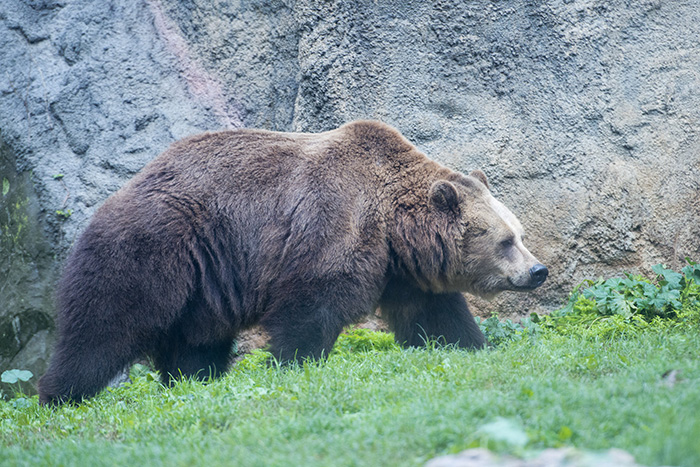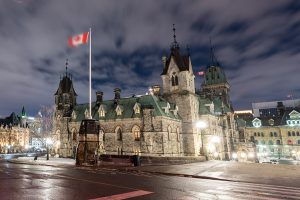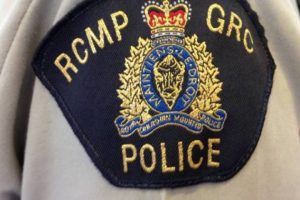Alberta grizzly bear killing policy under fire
Jessica Lee,
Local Journalism Initiative Reporter
The province says up to 15 “problem” grizzly bears could be shot annually under a new public management tactic and once killed, the bruin becomes the property of the killer in what the government continues to insist is not a hunt.
Alberta Forestry and Parks Minister Todd Loewen said over the last number of years, the annual average has been about 20 grizzlies killed per year from negative human interactions.
Conservationists and grizzly bear experts, including the researcher hired by the province to write grizzly bear status reports in 2010 and 2022, dispute this. Marco Festa-Bianchet, calls the minister’s data vague and sees the new management tactic as a “backdoor way to reopen hunting the species.”
“This notion that there are 20 bears euthanized per year – that’s like 10 times more than what’s actually happening,” said Festa-Bianchet, Universté de Sherbrooke biologist, who has 40 years of experience working in large mammal ecology and conservation.
“Is he mixing in black bears. Is he making that up? I have no idea where that number comes from because it’s certainly not the information I had when I wrote the status reports.”
The most recent status report shows lethal removal of problem grizzly bears by agency control accounted for 25 bears destroyed over 2009-2018, averaging about 2.5 euthanizations annually. The data was pulled from the province’s open government portal.
A table shows grizzly bear mortality rates from 2009-2018. According to the province, an average of about two to three ‘problem’ bears were destroyed by agency control annually.
Another report on grizzly bear mortality by Alberta Environment and Parks in 2020 shows there were 12 total euthanizations from 2009-2020 in bear management areas 4, 5, and 6, which includes Canmore, Kananaskis Country and surrounding areas. There are seven bear management areas across the province as outlined in the provincial grizzly bear recovery plan.
“The Government of Alberta essentially stopped producing that information. … There’s nothing there that’s publicly available for the last four or five years,” said Festa-Bianchet. “So, who knows where this new number is coming from.”
Festa-Bianchet further noted that despite producing the latest grizzly bear status report in 2022, the document has not been made publicly available online, unlike the 2010 report. He recently discovered it has yet to undergo approval and has not been told the reason why.
Minister insists grizzly hunt hasn’t returned
Since 2006, hunting grizzly bears has been outlawed by the provincial government. In 2010, the species was designated as threatened by criteria under the International Union for Conservation of Nature (IUCN), which states a population of less than 1,000 sexually mature bears is considered threatened. At that time, there were an estimated 700-800 grizzly bears in Alberta.
The most recent province-wide census of grizzlies showed a total population of between 856 and 973 in 2021.
Forestry and Parks claims that as the species’ population has slowly grown, so too has the number and severity of negative human-grizzly bear interactions.
In mid-June, the province amended regulations under the Wildlife Act, allowing what it’s calling a network of public wildlife management responders to track and kill grizzly bears – not accompanied by a cub – that are involved in a human-bear conflict or an area of concern with authorization from provincial wildlife officers.
This could include a bruin that has injured or killed a human or that poses a risk to life, livestock or property.
Loewen said not every situation that fits this description will be deemed appropriate to be dealt with by a member of the public.
“For instance, if it’s a dangerous situation and there’s a dangerous bear, and the bear’s visible, then we would expect the responding wildlife officer to take care of the problem animal at that point,” he said.
“But quite often, what happens if, say a grizzly bear comes in and kills, let’s say, 20 sheep in a sheep yard, that bear isn’t just standing there waiting for an officer to show up. At that point, the officer would have to go out and try to search and pursue and find this bear to deal with the problem.”
This could be an instance where a member of the public selected from a shortlist of eligible applicants is called to respond to what the province says can be a “time-consuming and resource-intensive affair” for provincial wildlife staff. Only adult residents of Alberta with a recreational licence to hunt under Section 29 of the Wildlife Act can apply to be selected from the wildlife management responder network.
Loewen insists the same parameters required of provincial wildlife officers would apply to selected members of the public. He said there’s no reason to suggest those Albertans that “[have] the experience of being in the outdoors and shooting big game, [are] any less qualified to deal with this issue than an officer.”
Those members of the public would be told when, where and what identified grizzly bear to kill, and with what equipment is allowed.
The minister further insisted this is not a hunt, though, the ministerial order outlining the change in the Wildlife Act specifically states, “despite its status as a threatened animal, the hunting of Ursus arctos (Brown (Grizzly) Bear) is permitted under Section 53.1.”
Festa-Bianchet argued if the identified bruin becomes the property of the member of the public selected to shoot it, it is a hunt.
“It’s a hunt that is disguised as defending Alberta families against these ‘mean’ bears,” he said.
Since 2005, Forestry and Parks says there have been eight people killed by grizzly bears and 62 grizzly bear maulings, in addition to 897 livestock losses since 2016.
Loewen cited the killing of a Lethbridge couple and their dog by a grizzly bear in the backcountry of Banff National Park in September 2023 as a recent example of predatory behaviour by the species, which the ministry claims are on the rise.
A post-mortem examination of the 25-year-old bear by Parks Canada found it was a non-lactating female, meaning there were no cubs around that she would have been protecting to prompt an attack.
Grizzly bear expert Bruce McLellan, who is also former president of the International Association for Bear Research and Management and co-chair of the IUCN Bear Specialist Group was interviewed by the Outlook at the time. He said the incident did not sound like a surprise encounter but that it also does not mean it was predatory.
“She lived 25 years without attacking anybody, and she’s probably had lots of opportunity, so something changed,” he said, noting there is a chance the couples’ dog could have agitated the bear.
Loewen said the information he has received is that the last four human deaths by grizzly bears in Alberta were “predatory in nature.”
He said changes to the Wildlife Act were made in response to years of complaints from rural municipalities and residents concerned about wildlife damage and safety issues with grizzly bears, in particular.
More consultation, data needed: NDP environment critic
Banff-Kananaskis MLA and the NDP’s environment and tourism critic Sarah Elmeligi criticized the minister for proceeding with the amendment without formal consultation with stakeholders or private landowners.
“I can appreciate that he’s had conversations with folks at meetings and community events where they’ve expressed concern about grizzly bears on their land or potential conflict situations – I’m sure they have.
“But that’s not the same thing as consultation … Consultation is a process where you’re actually gathering data and you can say ‘this many people said this.’ That is not what has happened here.”
A bear biologist, Elmeligi acknowledged that grizzly bears can be dangerous but said she believes the minister is misrepresenting the reality of how the species interacts on the landscape.
“He’s fear-mongering Albertans and painting this picture that there’s also these bloodthirsty grizzly bears running around the landscape, killing people and eating things, and that is, frankly, just not the case.
“What we know from the grizzly bear recovery plan and the data from the updated grizzly bear status report that came out in 2022, is that there are two to three grizzly bears per year that are euthanized because of extreme human-bear conflict.”
The grizzly bear recovery plan, updated in 2020, notes that since the plan was adopted in 2008 there has been an increase in human-grizzly bear conflict on private property adjacent to public land. In large part, because of increasing human encroachment on bear habitat.
But there is no data to support that killing bears will reduce human conflict, Elmeligi said.
“We do know and appreciate that addressing human-bear conflict is really important and that coexistence takes work. But what we also know, and what the science really clearly shows, is that killing bears that engage in conflict does not reduce conflict risk.”
Instead, implementing non-lethal bear management strategies like aversive conditioning, supporting ranchers and farmers by building electric fencing to protect their livelihood and reducing wildlife attractants, can and has worked in the past.
In the Bow Valley, attractant management activities have progressed from securing garbage, to passing bylaws banning bird feeders and fruit trees, and to the removal of natural bear forage such as buffaloberry occurring at the edges of communities.
“These targeted programs decreased conflict incidents specific to these attractants,” states the grizzly bear recovery plan. “As grizzly bear occurrence increases in other parts of their range, it is anticipated that other communities will experience similar conflict patterns, and can benefit from the lessons learned in the Bow Valley.”
The recovery plan further recommended employing human-wildlife conflict specialists across all seven of its bear management areas. The last person in that position retired in 2022, however, and currently there are none.
“There’s a whole suite of recommendations in that plan that have not been implemented,” said Elmeligi.
“In my opinion, as a bear biologist and also just as a person who appreciates Alberta wildlife, until we have exhausted all of the recommendations in the grizzly bear recovery plan, I don’t think we should be looking at providing the public with opportunities to kill bears.”
Elmeligi also acknowledged there are some gaps in the recovery plan. Namely, how it quantifies recovery of the species in Alberta.
“That’s one of the continual criticisms of the provincial grizzly bear recovery plan is that recovery isn’t really defined as a population number. It should be defined for each bear management area,” she said.
“That is a big part of this. The idea of having a listing of threatened animals or endangered animals is that you then work to recover those populations so that eventually you can take them off that list. That’s the whole principle behind all this, but we don’t really have a very good definition of what would be required to remove grizzly bears from the list of threatened species in Alberta.”
The latest publicly available population census data estimated there were between 856 and 973 grizzly bears in the province in 2021. The IUCN defines an animal as threatened if there are less than 1,000 breeding individuals in a population.
In a recent press release, the province claims grizzly bear numbers have increased from about 800 to more than 1,150.
Loewen, who said that number was provided to him by Alberta Environment and Protected Areas wildlife officials, suggested it was a conservative estimate.
“I know there’s probably many people that would disagree and suggest there is more. But those are the numbers provided by the wildlife professionals,” he said.
Whether that figure is accurate, by biologist and conservationist expertise, the number of mature bears would still not be enough to remove it as a threatened species as defined by the IUCN.
Loewen noted that although the ban to hunt grizzly bears remains in place, there is no legislation in Alberta that states a threatened species cannot be hunted.
“The classic example of that is bison, which is also classified as threatened. And we do have a hunting season for bison. But again, the grizzly bear does not have a hunting season. This isn’t even a hunt. It’s, again, the residents of Alberta being able to help with the job that Fish and Wildlife officers do.”
Elmeligi and Festa-Bianchet highlighted concerns about a lack of clarity in the process, suggesting it could lead to errors and delay effective management actions that could be better handled by trained wildlife officers.
They expressed concern for how a member of the public might determine which grizzly bear is the right one that’s been authorized to be killed.
“How do you know it’s the right bear,” Festa-Bianchet questioned. “Fish and Wildlife and conservation officers are trained to identify the bear, to realize when there is a problem and if there are alternatives.”
Loewen said once a grizzly is killed, it will have to be brought to wildlife officials to be looked over to determine it was the identified bear. He said a necropsy will look at its age and any other factors that may determine what led to it “becoming a problem.”
Education initiatives continuing
The province says in addition to the new public network of wildlife management responders, it will continue to fund educational initiatives like community BearSmart and WildSmart programs and the Waterton Biosphere – Carnivores and Communities program, which offers Albertans in the agriculture industry methods of preventing conflicts and losses due to carnivores, such as disposing of livestock carcasses in bear-proof bins. There was no indication that funding for these initiatives would be increasing, however.
It also said it would be working to restore important habitat for a range of species through methods like prescribed burns to create clearings and encourage new vegetation growth for wildlife food sources, and cited recent improvements to parks and campgrounds in Kananaskis, with other projects underway.
“When it comes to habitat enhancement, we’ve done prescribed burns and mechanical clearing. For instance, in the Spray Lakes West Campground, we’ve done mechanical clearing and made the campground smaller, so it wasn’t spread out so much,” said Loewen.
“We’ve also done some mechanical clearing beyond the campground to create some habitat for bears to go to feed so as to create less disruption to campers and less dangerous situations there.”
Loewen said he anticipates applications will open for the wildlife management responder network this month and will become active once first authorization is made by a provincial wildlife officer. The fee to apply is $50 and he said funds raised would be used toward conservation efforts.
Jessica Lee,
Local Journalism Initiative Reporter
Rocky Mountain Outlook





